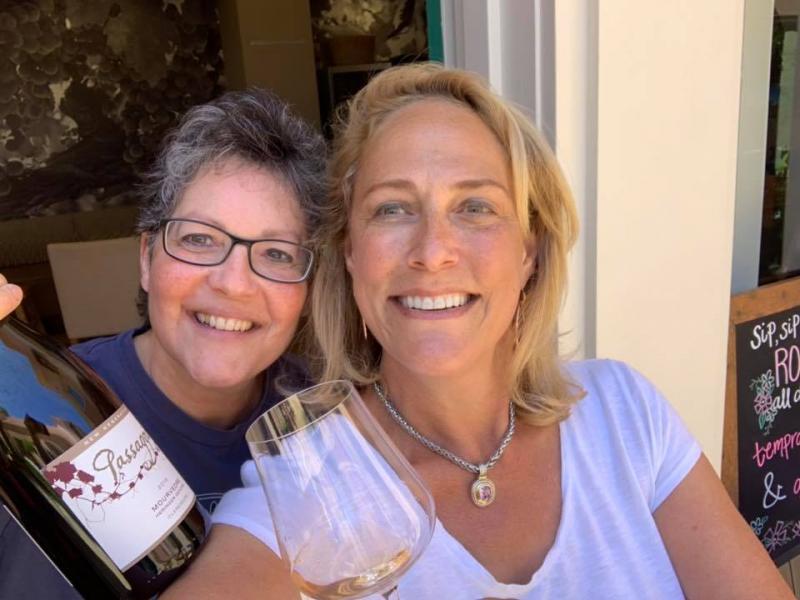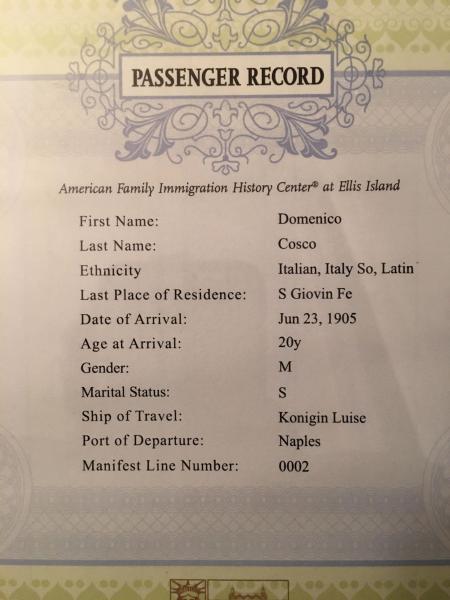 It is Summer and my favorite wine varietal is out in full force--rosé! Yes way, all day, I love the lightly skin-fermented, gentle pale, pink, salmon-hued, dry rosé style wine found mostly in Southern France and Italy. So, needless-to-say, I was delighted to find Passaggio Aglianico 2018 rosé, down the road from my West Coast abode, in Sonoma, California.And, made by a fellow Mid-Atlantic bred gal, Cynthia Cosco.
It is Summer and my favorite wine varietal is out in full force--rosé! Yes way, all day, I love the lightly skin-fermented, gentle pale, pink, salmon-hued, dry rosé style wine found mostly in Southern France and Italy. So, needless-to-say, I was delighted to find Passaggio Aglianico 2018 rosé, down the road from my West Coast abode, in Sonoma, California.And, made by a fellow Mid-Atlantic bred gal, Cynthia Cosco.
Seen left: Cynthia Cosco of Passaggio Wines and Citypeek's, Patti Neumann.
 Cosco's, Anglianco rosé is made by a black grape grown in the southern regions of Italy, mostly Basilicata and Campania, stylistically similar to its counter part varietals of Southern Italy and France. Although most red grape varieties are made for red table wines, there are quite a few that are used for Rosé (or, Rosato, in Italian).
Cosco's, Anglianco rosé is made by a black grape grown in the southern regions of Italy, mostly Basilicata and Campania, stylistically similar to its counter part varietals of Southern Italy and France. Although most red grape varieties are made for red table wines, there are quite a few that are used for Rosé (or, Rosato, in Italian).
$32 SRP, 114 cases produced.
seen left, Citypeek's Jessi Kim
When rosé wine is the primary product, it is produced with the skin contact method. Black-skinned grapes are crushed and the skins are allowed to remain in contact with the juice for a short period, typically one to three days. The must is then pressed, and the skins are discarded rather than left in contact throughout fermentation (as with red wine making). The longer that the skins are left in contact with the juice, the more intense the color of the final wine.
Seen left: Jessica Kim, at Passaggio Tasting Room, photo courtesy of Citypeek.
When a winemaker desires to impart more tannin and color to a red wine, some of the pink juice from the must can be removed at an early stage in what is known as the Saignée (from French bleeding) method. The red wine remaining in the vats is intensified as a result of the bleeding, because the volume of juice in the must is reduced, and the must involved in the maceration becomes more concentrated. The pink juice that is removed can be fermented separately to produce rosé.
Asked about the winemaking process, Cosco tells me, "The grapes were harvested from Heringer Estates in Clarksburg, California. Left on the skins about 4 hours and pressed off as soon as it came in the winery."
She also produces a rosé of tempranillo.

"Passaggio" means passage way or pass through, in Italian. The Passaggio wine brand name pays homage to Passaggio's great grand-father, Domenico Cosco, who immigrated to the USA, from Southern Italy in 1905. See his Passenger Record from Ellis Island. (Courtsey of Cynthia Cosco).
About the Winemaker:
In 2004 Cynthia "Cindy" Cosco, made a life changing decision. She left a15-year Law Enforcement career, in Northern Virginia, and moved West to California to pursue a passion for winemaking. Passaggio took a deep dive, entrenching herself in the industry, got a degree in enology from Napa Valley College, worked harvests, as a chemistin a wine lab and a later became a Lab Manager, at a custom crush facility in San Francisco, called Crushpad. At Crushpad, she later becoming their Winemaker, overseaing production of their white wine program. It was there that her wine label, Passaggio Wines was born.
Production has grown from a 'garagiste' size 50 cases of chardonnay, in 2008 to 1700 cases of multiple varietals in 2018. All wines are available in limited production via the Passaggio Wines Tasting room in the Historic Sonoma Plaza located 25 East Napa Street, Suite C, Sonoma, CA 95476 or via her wine club.
Follow CITYPEEK Patti's Food, Wine & Travels on Social Media:
 Connect Real-Time w/Patti:
Connect Real-Time w/Patti:
 Facebook: Click
Facebook: Click
 Twitter: Click
Twitter: Click
 Instagram: Click
Instagram: Click

 Add Events
Add Events Food, Wine & Travel News
Food, Wine & Travel News
 It is Summer and my favorite wine varietal is out in full force--rosé! Yes way, all day, I love the lightly skin-fermented, gentle pale, pink, salmon-hued, dry rosé style wine found mostly in Southern France and Italy. So, needless-to-say, I was delighted to find
It is Summer and my favorite wine varietal is out in full force--rosé! Yes way, all day, I love the lightly skin-fermented, gentle pale, pink, salmon-hued, dry rosé style wine found mostly in Southern France and Italy. So, needless-to-say, I was delighted to find  Cosco's, Anglianco
Cosco's, Anglianco 

 Instagram:
Instagram: